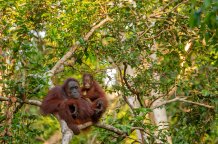articles

Safeguarding Indigenous Peoples’ lands could save primates
Safeguarding Indigenous Peoples’ lands could save primates
Safeguarding Indigenous Peoples' lands offers the best chance of preventing the extinction of the world's primates, researchers say.
More than two thirds of the planet's 521 primate species are threatened with extinction due to global pressures on their habitats from agriculture and extraction of natural resources.
New analysis by an international research team shows that Indigenous Peoples’ lands account for 30% of the area in which primates live (called their "range").
The range 71% of primate species includes Indigenous Peoples' lands – and the higher the proportion of land they share with Indigenous Peoples', the less likely a primate species is to be classified as threatened or as having declining populations.
The study team included the National Autonomous University of Mexico, the University of Illinois and the University of Exeter.
"We will only avert the mass extinction of primates if we respect and support Indigenous Peoples to maintain their languages, and cultural and symbolic ties to their lands and waters," said Dr Kim Hockings, of Centre for Ecology and Conservation on the University of Exeter’s Penryn Campus in Cornwall.
"Indigenous Peoples must be supported in their efforts to shield their lands from the unsustainable demands of multinational corporations, consumer nations, and national governments that favour short-term economic benefits over human rights, biodiversity, and environmental health.
"The enforced loss of connection between Indigenous Peoples and their lands worldwide results in the over-exploitation of natural resources and the erosion of unique socio-cultural connections between people and nature.
"Indigenous Peoples should be respected for their systems of knowledge and considered by the global conservation community as holders of essential information, land rights, and as partners in the quest to safeguard biodiversity."
Primates (prosimians, tarsiers, monkeys and apes) inhabit a wide range of tropical, subtropical and temperate forests, and woodlands.
A key factor placing primate populations at risk is habitat destruction to satisfy the unsustainable demands of industrial societies for food and non-food commodities.
The researchers say: "Halting Indigenous land dispossession, returning land to dispossessed Indigenous Peoples, and respecting and safeguarding Indigenous sovereignty represent critical priorities that are central in protecting animal and plant biodiversity, and reducing carbon emmisions.
"Based on their global assessment, the authors affirm that Indigenous perspectives, knowledge systems, and histories hold globally important conservation lessons.
"Safeguarding Indigenous Peoples’ lands, languages, and cultures and strengthening the rights of Indigenous Peoples represents our greatest chance to prevent the extinction of the world’s primates, our closest living biological relatives."
The paper, published in the journal Science Advances, is entitled: "Global importance of Indigenous Peoples, their lands, and knowledge systems for saving the world’s primates from extinction."
Date: 10 August 2022
